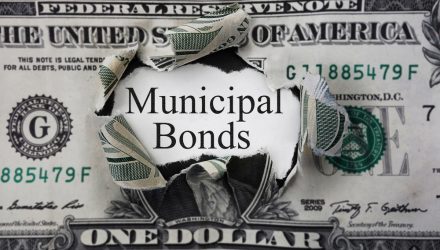Last year’s bond bonanza amid a flight to safety saw a large increase in capital inflows from banks and funds into municipal bonds. Investors looking for bond alternatives now can opt for a pair of muni-focused bond funds from Invesco with the Invesco National AMT-Free Municipal Bond ETF (PZA) and the Invesco VRDO Tax-Free Weekly ETF (PVI).
On one hand, PZA seeks to track the investment results of the ICE BofAML National Long-Term Core Plus Municipal Securities Index. The fund generally will invest at least 80% of its total assets in the components of the index.
The index is composed of U.S. dollar-denominated, tax-exempt municipal debt publicly issued by U.S. states and territories and their political subdivisions in the U.S. domestic market. PZA’s expense ratio comes in at 0.28%.
The other option, PVI, seeks to track the investment results of the Bloomberg U.S. Municipal AMT-Free Weekly VRDO Index. The fund generally will invest at least 80% of its total assets in the components of the index.
Bloomberg Index Services Limited compiles and calculates the index, which is comprised of municipal variable rate demand obligation bonds that are exempt from federal income tax and that have interest rates that reset weekly. PVI’s expense ratio comes in at 0.25%.
The Rise of Muni ETFs
According to a Bond Buyer article, banks increased their holdings of municipal bonds to $513 billion from $472 billion from 2019, an increase of 9%. The Bloomberg Barclays Municipal Bond index was up 7% within the past year as flight to safety amid the pandemic sell-offs sparked a bond buying spree across the wide spectrum of debt offerings.
“That’s consistent with a long-term trend of banks increasing their appetite for municipals and keeping more municipals on their balance sheet,” said Michael Decker, vice president of policy and research at Bond Dealers of America. “That’s the biggest part of the answer of who is buying these bonds.”
Additionally, a Federal Reserve quarterly flow of funds report noted a marked increase in muni bond holdings by ETFs as well. According to the Bond Buyer article, “ETFs held $64.5 billion in munis compared to $49.3 billion in 2019 — a 30% increase.”
“We’ve known that the muni ETF sector has been growing,” Decker said. “These numbers confirm it. It still represents a very small segment of the market, but it’s a segment that’s growing rapidly.”
For more news and information, visit the Innovative ETFs Channel.









